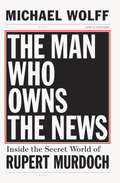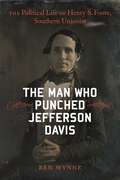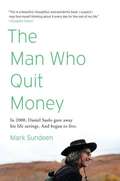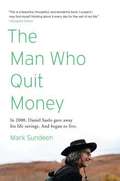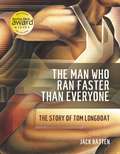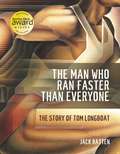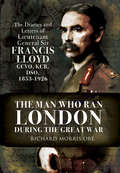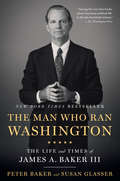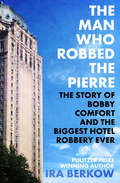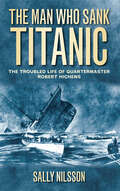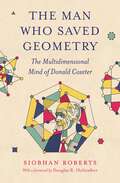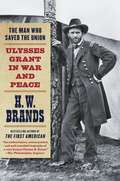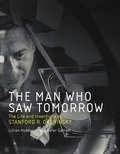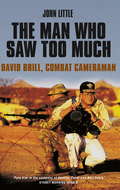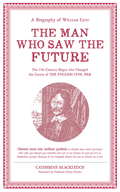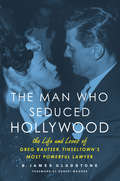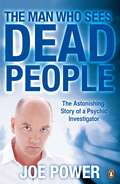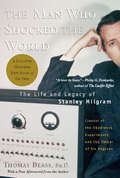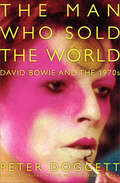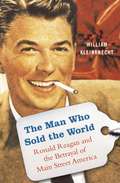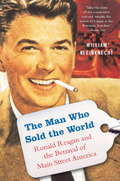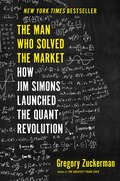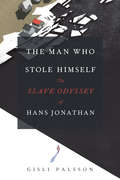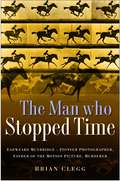- Table View
- List View
The Man Who Owns the News: Inside the Secret World of Rupert Murdoch
by Michael WolffMurdoch's News Corp holdings - from The New York Post, Fox News, The Australian, and most recently The Wall Street Journal, to name just a few - are vast , and his power is unrivalled. So what makes a man like this tick? Michael Wolff gives us the definitive answer in THE MAN WHO OWNS THE NEWS. With unprecedented access to Murdoch himself, his associates, and family, Wolff chronicles the astonishing growth of the $70 billion media kingdom. In intimate detail he probes the Murdoch family dynasty, from the battles that have threatened to destroy it to the reconciliations that seem to only make it stronger. Drawing upon hundreds of hours of interviews, he offers accounts of the Dow Jones takeover as well as plays for Yahoo! and Newsday as they've never been revealed before. But Murdoch is more than a predatory and merciless deal-maker. His company does not only generate dizzying profits and growth rates. His company generates the information that forms our understanding of the world. He presides over what we read, what we watch, what we come to believe about ourselves, to an extent that is without serious parallel anywhere on earth. In the words of Michael Wolff, Murdoch 'held more power over more time than any other contemporary figure'. This is an opportunity to see and hear one of the most vivid, powerful, unusual, menacing and captivating men of the age. One of the central figures of our times. Written in the irresistible style that only an award-winning columnist for 'Vanity Fair' can deliver, THE MAN WHO OWNS THE NEWS offers an exclusive glimpse into a man who wields extraordinary power and influence in the media on a worldwide scale - and whose family is being groomed to carry his legacy into the future.
The Man Who Punched Jefferson Davis: The Political Life of Henry S. Foote, Southern Unionist (Southern Biography Series)
by Ben WynneRegarded as one of the most vocal, well-traveled, and controversial statesmen of the nineteenth century, antebellum politician Henry Stuart Foote played a central role in a vast array of pivotal events. Despite Foote’s unique mark on history, until now no comprehensive biography existed. Ben Wynne fills this gap in his examination of the life of this gifted and volatile public figure in The Man Who Punched Jefferson Davis: The Political Life of Henry S. Foote, Southern Unionist.An eyewitness to many of the historical events of his lifetime, Foote, an opinionated native Virginian, helped to raise money for the Texas Revolution, provided political counsel for the Lone Star Republic’s leadership before annexation, and published a 400-page history of the region. In 1847, Mississippi elected him to the Senate, where he promoted cooperation with the North during the Compromise of 1850. One of the South’s most outspoken Unionists, he infuriated many of his southern colleagues with his explosive temperament and unorthodox ideas that quickly established him as a political outsider. His temper sometimes led to physical altercations, including at least five duels, pulling a gun on fellow senator Thomas Hart Benton during a legislative session, and engaging in run-ins with other politicians—notably a fistfight with his worst political enemy, Jefferson Davis. He left the Senate in 1851 to run for governor of Mississippi on a pro-Union platform and defeated Davis by a small margin. Several years later, Foote moved to Nashville, was elected to the Confederate Congress after Tennessee seceded, and continued his political sparring with the Confederate president.From Foote’s failed attempt to broker an unauthorized peace agreement with the Lincoln government and his exile to Europe to the publication of his personal memoir and his appointment as director of the United States mint in New Orleans, Wynne constructs an entertaining and nuanced portrait of a singular man who constantly challenged the conventions of southern and national politics.
The Man Who Quit Money
by Mark SundeenA Walden for the 21st century, the true story of a man who has radically reinvented "the good life" In 2000, Daniel Suelo left his life savings; all thirty dollars of it; in a phone booth. He has been living without money; and with a newfound sense of freedom and security; ever since. The Man Who Quit Money is an account of how one man learned to live, sanely and happily, without earning, receiving, or spending a single cent. Suelo doesn't pay taxes, or accept food stamps or welfare. He lives in caves in the Utah canyonlands, forages wild foods and gourmet discards. He no longer even carries an I. D. Yet he manages to amply fulfill not only the basic human needs-for shelter, food, and warmth-but, to an enviable degree, the universal desires for companionship, purpose, and spiritual engagement. In retracing the surprising path and guiding philosophy that led Suelo into this way of life, Sundeen raises provocative and riveting questions about our relationships with money and the decisions we all make, by default or by design; about how we live and how we might live better.
The Man Who Quit Money
by Mark SundeenIn 2000, Daniel Suelo left his life savings-all thirty dollars of it-in a phone booth. He has lived without money-and with a newfound sense of freedom and security-ever since. The Man Who Quit Money is an account of how one man learned to live, sanely and happily, without earning, receiving, or spending a single cent. Suelo doesn't pay taxes, or accept food stamps or welfare. He lives in caves in the Utah canyonlands, forages wild foods and gourmet discards. He no longer even carries an I. D. Yet he manages to amply fulfill not only the basic human needs-for shelter, food, and warmth-but, to an enviable degree, the universal desires for companionship, purpose, and spiritual engagement. In retracing the surprising path and guiding philosophy that led Suelo into this way of life, Sundeen raises provocative and riveting questions about the decisions we all make, by default or by design, about how we live-and how we might live better.
The Man Who Ran Faster Than Everyone: The Story of Tom Longboat
by Jack BattenTom Longboat was a hero. A member of the Onondaga Nation, he was born on the Six Nations reserve in Oshwegen, near Brantford, Ontario. Despite poverty, poor training, and prejudice, Longboat went on to become one of the world's best runners. In 1907, at the height of his fame, he won the Boston Marathon and ran in the 1908 Olympic Marathon. Longboat was one of the best-known people of his day, and certainly the most prominent member of the Six Nations. Throughout his career he had to race against opponents, as well as rumors of illegal running activities. Nevertheless, he maintained his dignity, and his achievements still inspire people who understand the great pleasure of running, and running fast.
The Man Who Ran Faster Than Everyone: The Story of Tom Longboat
by Jack BattenTom Longboat was a hero. A member of the Onondaga Nation, he was born on the Six Nations reserve in Oshwegen, near Brantford, Ontario. Despite poverty, poor training, and prejudice, Longboat went on to become one of the world's best runners. In 1907, at the height of his fame, he won the Boston Marathon and ran in the 1908 Olympic Marathon. Longboat was one of the best-known people of his day, and certainly the most prominent member of the Six Nations. Throughout his career he had to race against opponents, as well as rumors of illegal running activities. Nevertheless, he maintained his dignity, and his achievements still inspire people who understand the great pleasure of running, and running fast.From the Trade Paperback edition.
The Man Who Ran London During the Great War: The Diaries and Letters of Lieutenant General Sir Francis Lloyd, GCVO, KCB, DSO, 1853–1926
by Richard MorrisIn 1913 Lieutenant General Sir Francis Lloyd was appointed to the supreme position reserved for Guardsmen, the command of the London Districts. The war saw an extension of his responsibilities to include the hospitals and main railway termini in the metropolis. He was also put in charge of the construction of the defensive circle of trenches around London. Whether it was meeting hospital trains returning from the front with wounded soldiers, or visiting areas of the City that had suffered from the Zeppelin and Gotha Bomber air raids, Francis Lloyds presence would help to revive the populations flagging morale. This led him to be described by newspapers as The Man who runs London.
The Man Who Ran Washington: The Life and Times of James A. Baker III
by Peter Baker Susan GlasserFrom two of America's most revered political journalists comes the definitive biography of legendary White House chief of staff and secretary of state James A. Baker III: the man who ran Washington when Washington ran the world. <P><P>For a quarter-century, from the end of Watergate to the aftermath of the Cold War, no Republican won the presidency without his help or ran the White House without his advice. James Addison Baker III was the indispensable man for four presidents because he understood better than anyone how to make Washington work at a time when America was shaping events around the world. The Man Who Ran Washington is a page-turning portrait of a power broker who influenced America's destiny for generations. <P><P>A scion of Texas aristocracy who became George H. W. Bush's best friend on the tennis courts of the Houston Country Club, Baker had never even worked in Washington until a devastating family tragedy struck when he was thirty-nine. Within a few years, he was leading Gerald Ford's campaign and would go on to manage a total of five presidential races and win a sixth for George W. Bush in a Florida recount. He ran Ronald Reagan's White House and became the most consequential secretary of state since Henry Kissinger. He negotiated with Democrats at home and Soviets abroad, rewrote the tax code, assembled the coalition that won the Gulf War, brokered the reunification of Germany and helped bring a decades-long nuclear superpower standoff to an end. Ruthlessly partisan during campaign season, Baker governed as the avatar of pragmatism over purity and deal-making over division, a lost art in today's fractured nation. <P><P>His story is a case study in the acquisition, exercise, and preservation of power in late twentieth-century America and the story of Washington and the world in the modern era--how it once worked and how it has transformed into an era of gridlock and polarization. This masterly biography by two brilliant observers of the American political scene is destined to become a classic. <P><P><b>A New York Times Bestseller</b>
The Man Who Robbed the Pierre: The Story of Bobby Comfort and the Biggest Hotel Robbery Ever
by Ira BerkowThis Pulitzer Prize–winning author&’s true account of the thief behind the famed 1972 heist is &“an engrossing crime biography . . . [and] a fast-paced romp&” (Kirkus Reviews). Growing up in Rochester, New York, Bobby Comfort wanted to be a good something. It just so happened that he was great at being a criminal. In January 1972, men in tuxedos robbed the Pierre, the luxurious Manhattan hotel, and got away with eleven million dollars&’ worth of cash and jewelry. The police were baffled by how such a large-scale operation could go off so smoothly. The answer lay in the leader of the thieves, a man by the name of Bobby Comfort. He had taken to crime from a young age with card sharping and petty theft. Eventually, taking money from the rich was where he excelled. Sort of like Robin Hood—except for the part where he kept the loot himself—Comfort masterminded what was, at the time, the most lucrative heist in history, while appearing to his neighbors like an ordinary suburban family man. In this blend of insightful biography and true crime, Pulitzer Prize–winning journalist Ira Berkow chronicles the story, using first-hand accounts to weave together a fascinating portrait of a criminal and &“a corking good cops-and-robbers tale&” (Library Journal).
The Man Who Rode the Thunder
by William H. RankinIt was July 26, 1959. An F8U Crusader jet fighter streaked across the sky, down the Carolina coast, close to the speed of sound. Altitude: 47,000 feet. Flying conditions: Perfect. Marine Lt. Colonel William Rankin gave only a fleeting glance at the mounting black thunderheads far below. Seconds later began the most incredible 40 minutes in history. Here is the thrilling, detailed account of how Col. Rankin was forced to bail out at almost 50,000 feet without special pressure equipment. How, after dropping 7 miles in a free fall, he plunged into the grip of a violent storm--an inferno of turbulence, rain, hail, thunder and lightning such as no man had ever seen before. For over a half hour, Col. Rankin was an airborne captive of the storm, and his eventual survival was against overwhelming odds. Here is the true story behind that headline-making event. And here is the adventurous life of the Marine--a life that fitted him so well for the fantastic ordeal he was forced to undergo. You will go with Col. Rankin as he recalls his adventures as a Marine Sergeant in World War II; into early flight training to become one of the three oldest cadets ever admitted for flying. You will fly with him as one of the famous "Fearless Four" as they bomb the bridges of Toko-Ri in Korea. You will know the thrill of trailblazing the jet age when Col. Rankin assumes command of the famous Marine Fighter Squadron 122. Finally, you will share one of the most astounding adventures of modern times--a thrilling epic of man against the terrifying forces of nature--the story of a man who survived because he had lived and trained in the true tradition of the United States Marine Corps. This book also serves as an important contribution to medical inquiries into what happens to man at great altitudes.
The Man Who Sank Titanic: The Troubled Life of Quartermaster Robert Hichens
by Sally NilssonRobert Hichens has gone down in history as the man who was given the famous order to steer the Titanic away from the iceberg and failed. Following this, his falling out with the ‘Unsinkable Molly Brown’ over the actions of the lifeboats saw him branded a coward and his name indelibly tarnished. A key witness at both US and British Inquiries, Robert returned to a livelihood where fellow crewmen considered him jinxed. But Robert had a long career and was a hardworking, ambitious seaman. A fisherman at 19, he quickly became a junior officer in the merchant navy. In the Second World War he was part of a cargo ship convoy on route to Africa where his ship dodged mines, U-boats and enemy aircraft. To Robert, being at sea was everything but the dark memories of the Titanic were never far away and in 1933 a failed murder attempt after a bitter feud nearly cost Robert his life. Here Robert’s great-granddaughter Sally Nilsson seeks to set the record straight and reveal the true character of the man her family knew. This is one man’s story of survival, betrayal and determination.
The Man Who Saved Geometry: The Multidimensional Mind of Donald Coxeter
by Siobhan RobertsAn illuminating biography of one of the greatest geometers of the twentieth centuryDriven by a profound love of shapes and symmetries, Donald Coxeter (1907–2003) preserved the tradition of classical geometry when it was under attack by influential mathematicians who promoted a more algebraic and austere approach. His essential contributions include the famed Coxeter groups and Coxeter diagrams, tools developed through his deep understanding of mathematical symmetry. The Man Who Saved Geometry tells the story of Coxeter&’s life and work, placing him alongside history&’s greatest geometers, from Pythagoras and Plato to Archimedes and Euclid—and it reveals how Coxeter&’s boundless creativity reflects the adventurous, ever-evolving nature of geometry itself. With an incisive, touching foreword by Douglas R. Hofstadter, The Man Who Saved Geometry is an unforgettable portrait of a visionary mathematician.
The Man Who Saved the Union: Ulysses Grant in War and Peace
by H. W. BrandsFrom New York Times bestselling author H. W. Brands, a masterful biography of the Civil War general and two-term president who saved the Union twice, on the battlefield and in the White House, holding the country together at two critical turning points in our history. Ulysses Grant rose from obscurity to discover he had a genius for battle, and he propelled the Union to victory in the Civil War. After Abraham Lincoln's assassination and the disastrous brief presidency of Andrew Johnson, America turned to Grant again to unite the country, this time as president. In Brands's sweeping, majestic full biography, Grant emerges as a heroic figure who was fearlessly on the side of right. He was a beloved commander in the field but willing to make the troop sacrifices necessary to win the war, even in the face of storms of criticism. He worked valiantly to protect the rights of freedmen in the South; Brands calls him the last presidential defender of black civil rights for nearly a century. He played it straight with the American Indians, allowing them to shape their own fate even as the realities of Manifest Destiny meant the end of their way of life. He was an enormously popular president whose memoirs were a huge bestseller; yet within decades of his death his reputation was in tatters, the victim of Southerners who resented his policies on Reconstruction. In this page-turning biography, Brands now reconsiders Grant's legacy and provides a compelling and intimate portrait of a man who saved the Union on the battlefield and consolidated that victory as a resolute and principled political leader.
The Man Who Saw Tomorrow: The Life and Inventions of Stanford R. Ovshinsky (The\mit Press Ser.)
by Lillian Hoddeson Peter GarrettThe first full-length biography of a brilliant, self-taught inventor whose innovations in information and energy technology continue to shape our world.The Economist called Stanford R. Ovshinsky (1922–2012) “the Edison of our age,” but this apt comparison doesn't capture the full range of his achievements. As an independent, self-educated inventor, Ovshinsky not only created many important devices but also made fundamental discoveries in materials science. This book offers the first full-length biography of a visionary whose energy and information innovations continue to fuel our post-industrial economy.In The Man Who Saw Tomorrow, Lillian Hoddeson and Peter Garrett tell the story of an unconventional genius with no formal education beyond high school who invented, among other things, the rechargeable nickel metal hydride batteries that have powered everything from portable electronics to hybrid cars, a system for mass-producing affordable thin-film solar panels, and rewritable CDs and DVDs. His most important discovery, the Ovshinsky effect, led to a paradigm shift in condensed matter physics and yielded phase-change memory, which is now enabling new advances in microelectronics. A son of the working class who began as a machinist and toolmaker, Ovshinsky focused his work on finding solutions to urgent social problems, and to pursue those goals, he founded Energy Conversion Devices, a unique research and development lab. At the end of his life, battered by personal and professional losses, Ovshinsky nevertheless kept working to combat global warming by making solar energy “cheaper than coal”—another of his many visions of a better tomorrow.
The Man Who Saw Too Much: David Brill, Combat Cameraman
by John LittleThis is the story of David Brill, one of the very best of Australian cameramen - past and present. He is in the same company as Damien Parer and Neil Davis.Over the past forty years he has covered wars and disasters all over the world. He filmed the fall of Saigon. He was in Moscow during the collapse of communism. He has covered countless other conflicts and natural disasters in Asia, Africa and North and South America.He has been single-mindedly dedicated to the pursuit of his craft: to get the story, get the film - always to preserve and present the human dimension, no matter how large or mindless the conflict or event.David Brill has paid a high price for this uncompromising style. He has two failed marriages, and at times has been overcome by demons such as alcohol. This biography is also a great adventure story, a journey through war zones and various hell holes of the world. And it is an inside look at what makes some people follow a profession where their life is on the line - as a standard feature of their day.
The Man Who Saw the Future
by Catherine BlackledgeA spellbinding tale of prophecy, power and politics, this book tells the fascinating story of the 17th-century astrologer William Lilly how his celestial forecasts of the future changed the course of the English Civil War, and the establishment s attempts to silence him.Winter, 1643. Astrologer William Lilly is gazing at a chamber pot. Parliament has asked him to help: will leader John Pym live or die? Using an ancient astrological technique called horary, Lilly predicts Pym will die in eight days time. He is correct.In the pages of his best-selling pamphlets, Lilly enthrals the civil war-torn nation with his uncannily accurate astral forecasts of who will triumph in combat. He advises the New Model Army on when to fight based on his judgement of King Charles I s horoscope; the key battle of Naseby is won with this astrological intelligence. Foreseeing the King s death seals his status as the nation s arch magus. But not everyone is happy with Parliament s new prophet and his enemies begin to plot their revenge. Can Lilly s astonishing gift help him best those in power, and save his profession and his life?With a cast of star-gazers, soldiers and scryers; politicians, priests and prophets, internationally acclaimed author Catherine Blackledge grants a fresh insight into a tumultuous period: illuminating William Lilly s extraordinary life and revealing the secrets of his astonishing foresight.
The Man Who Seduced Hollywood: The Life and Loves of Greg Bautzer, Tinseltown's Most Powerful Lawyer
by Robert Wagner B. James GladstoneIn Hollywood history, no other lawyer has achieved the movie star-like fame and glamour that Greg Bautzer enjoyed. This revealing biography tells, for the first time, the amazing story of a self-made man who for 50 years used his irresistible charm and prodigious legal talent to dominate the courtrooms, boardrooms, and bedrooms of Hollywood. Columnists of the 1930s through 1950s dubbed him "Hollywood Bachelor Number One," and for good reason. His long-term relationships and momentary conquests were a who's who of leading ladies. Through exclusive interviews with those who knew him best, the book uncovers the inner workings of not only Bautzer the high-powered Hollywood lawyer--whose clients included billionaire Howard Hughes--but Bautzer the man.
The Man Who Sees Dead People: The Astonishing Story Of A Psychic
by Joe PowerFor almost a decade, psychic medium Joe Power has used his extraordinary powers to investigate high-profile, unsolved crimes around the world, including, most recently, the disappearance of Madeleine McCann.But it wasn't always this way. Joe had denied his psychic abilities until the day his brother was found dead. Then messages from the spirit world led him to see the shocking truth behind the tragedy . . . his brother had been murdered.Joe realized he could no longer ignore the startling visions and voices in his head. He vowed to use his psychic gift to help solve the murder cases that were leaving detectives baffled, and loved ones without closure. In The Man Who Sees Dead People he tells the astonishing story of his life for the first time.
The Man Who Shocked The World: The Life and Legacy of Stanley Milgram
by Thomas BlassCreator of the famous Obedience Experiments and originator of the ?six degrees of separationOCO theory, Stanley Milgram transformed our understanding of human nature and continues to be one of the most important figures in psychology and beyond. In this sparkling biography, Thomas Blass captures the colorful personality and pioneering work of a visionary scientist who revealed the hidden workings of our social world. In this new paperback edition, he includes an afterword connecting MilgramOCOs theories to torture, war crimes, and Abu Ghraib. "
The Man Who Sold the World: David Bowie and the 1970s
by Peter DoggettThe Man Who Sold the World is a critical study of David Bowie's most inventive and influential decade, from his first hit, "Space Oddity," in 1969, to the release of the LP Scary Monsters (and Super Creeps) in 1980. Viewing the artist through the lens of his music and his many guises, the acclaimed journalist Peter Doggett offers a detailed analysis—musical, lyrical, conceptual, social—of every song Bowie wrote and recorded during that period, as well as a brilliant exploration of the development of a performer who profoundly affected popular music and the idea of stardom itself.Dissecting close to 250 songs, Doggett traces the major themes that inspired and shaped Bowie's career, from his flirtations with fascist imagery and infatuation with the occult to his pioneering creation of his alter-ego self in the character of Ziggy Stardust. What emerges is an illuminating account of how Bowie escaped his working-class London background to become a global phenomenon. The Man Who Sold the World lays bare the evolution of Bowie's various personas and unrivaled career of innovation as a musician, singer, composer, lyricist, actor, and conceptual artist. It is a fan's ultimate resource—the most rigorous and insightful assessment to date of Bowie's artistic achievement during this crucial period.
The Man Who Sold the World: Ronald Reagan and the Betrayal of Main Street America
by William KleinknechtSince Ronald Reagan left office--and particularly after his death--his shadow has loomed large over American politics: Republicans and many Democrats have waxed nostalgic, extolling the Republican tradition he embodied, the optimism he espoused, and his abilities as a communicator. This carefully calibrated image is complete fiction, argues award-winning journalist William Kleinknecht. The Reagan presidency was epoch shattering, but not--as his propagandists would have it--because it invigorated private enterprise or made America feel strong again. His real legacy was the dismantling of an eight-decade period of reform in which working people were given an unprecedented sway over our politics, our economy, and our culture. Reagan halted this almost overnight.In the tradition of Thomas Frank's What's the Matter with Kansas?, Kleinknecht explores middle America--starting with Reagan's hometown of Dixon, Illinois--and shows that as the Reagan legend grows, his true legacy continues to decimate middle America.
The Man Who Sold the World: Ronald Reagan and the Betrayal of Main Street America
by William KleinknechtSince Ronald Reagan left office-and particularly after his death-his shadow has loomed large over American politics: Republicans and many Democrats have waxed nostalgic, extolling the Republican tradition he embodied, the optimism he espoused, and his abilities as a communicator. This carefully calibrated image is complete fiction, argues award-winning journalist William Kleinknecht. The Reagan presidency was epoch shattering, but not-as his propagandists would have it-because it invigorated private enterprise or made America feel strong again. His real legacy was the dismantling of an eight-decade period of reform in which working people were given an unprecedented sway over our politics, our economy, and our culture. Reagan halted this almost overnight. In the tradition of Thomas Frank’s What’s the Matter with Kansas?, Kleinknecht explores middle America-starting with Reagan’s hometown of Dixon, Illinois-and shows that as the Reagan legend grows, his true legacy continues to decimate middle America.
The Man Who Solved the Market: How Jim Simons Launched the Quant Revolution
by Gregory ZuckermanGregory Zuckerman, the bestselling author of The Greatest Trade Ever and The Frackers, answers the question investors have been asking for decades: How did Jim Simons do it? <P><P>Shortlisted for the Financial Times/McKinsey Business Book of the Year AwardJim Simons is the greatest money maker in modern financial history. No other investor--Warren Buffett, Peter Lynch, Ray Dalio, Steve Cohen, or George Soros--can touch his record. <P><P>Since 1988, Renaissance's signature Medallion fund has generated average annual returns of 66 percent. The firm has earned profits of more than $100 billion; Simons is worth twenty-three billion dollars.Drawing on unprecedented access to Simons and dozens of current and former employees, Zuckerman, a veteran Wall Street Journal investigative reporter, tells the gripping story of how a world-class mathematician and former code breaker mastered the market. Simons pioneered a data-driven, algorithmic approach that's sweeping the world. <P><P>As Renaissance became a market force, its executives began influencing the world beyond finance. Simons became a major figure in scientific research, education, and liberal politics. Senior executive Robert Mercer is more responsible than anyone else for the Trump presidency, placing Steve Bannon in the campaign and funding Trump's victorious 2016 effort. <P><P>Mercer also impacted the campaign behind Brexit.The Man Who Solved the Market is a portrait of a modern-day Midas who remade markets in his own image, but failed to anticipate how his success would impact his firm and his country. It's also a story of what Simons's revolution means for the rest of us. <P><P><b>A New York Times Bestseller</b>
The Man Who Stole Himself: The Slave Odyssey of Hans Jonathan
by Gisli PalssonThe island nation of Iceland is known for many things--majestic landscapes, volcanic eruptions, distinctive seafood--but racial diversity is not one of them. So the little-known story of Hans Jonathan, a free black man who lived and raised a family in early nineteenth-century Iceland, is improbable and compelling, the stuff of novels. In The Man Who Stole Himself, Gisli Palsson lays out the story of Hans Jonathan (also known as Hans Jónatan) in stunning detail. Born into slavery in St. Croix in 1784, Hans was taken as a slave to Denmark, where he eventually enlisted in the navy and fought on behalf of the country in the 1801 Battle of Copenhagen. After the war, he declared himself a free man, believing that he was due freedom not only because of his patriotic service, but because while slavery remained legal in the colonies, it was outlawed in Denmark itself. He thus became the subject of one of the most notorious slavery cases in European history, which he lost. Then Hans ran away--never to be heard from in Denmark again, his fate unknown for more than two hundred years. It's now known that Hans fled to Iceland, where he became a merchant and peasant farmer, married, and raised two children. Today, he has become something of an Icelandic icon, claimed as a proud and daring ancestor both there and among his descendants in America. The Man Who Stole Himself brilliantly intertwines Hans Jonathan's adventurous travels with a portrait of the Danish slave trade, legal arguments over slavery, and the state of nineteenth-century race relations in the Northern Atlantic world. Throughout the book, Palsson traces themes of imperial dreams, colonialism, human rights, and globalization, which all come together in the life of a single, remarkable man. Hans literally led a life like no other. His is the story of a man who had the temerity--the courage--to steal himself.
The Man Who Stopped Time
by Brian CleggBrian Clegg tells the extraordinary story of the pioneer of photography, eccentric Victorian inventor Eadweard Muybridge. If most of us have seen Muybridge's distinctive stop-motion photographs, all of us have seen the fruit of his extraordinary technological innovation: today's cinema and television. But it is his personal life that possesses all the ingredients of a classic non-fiction best-seller: a passionately driven man struggling against the odds; dire treachery and shocking betrayal; a cast of larger-than-life characters set against a backdrop of San Francisco and the Far West in its most turbulent and dangerous era; a profusion of scientific and artistic advances and discoveries, one hotly following on another; the nervous intensity of two spectacular courtroom dramas (one pitting Muybridge against the richest man in the land and staring ruin in the face, the other sees him fighting for his life). And for the opening act, a foul murder on a dark and stormy night.
